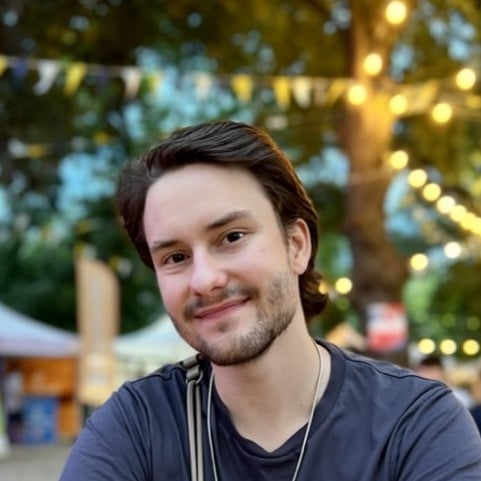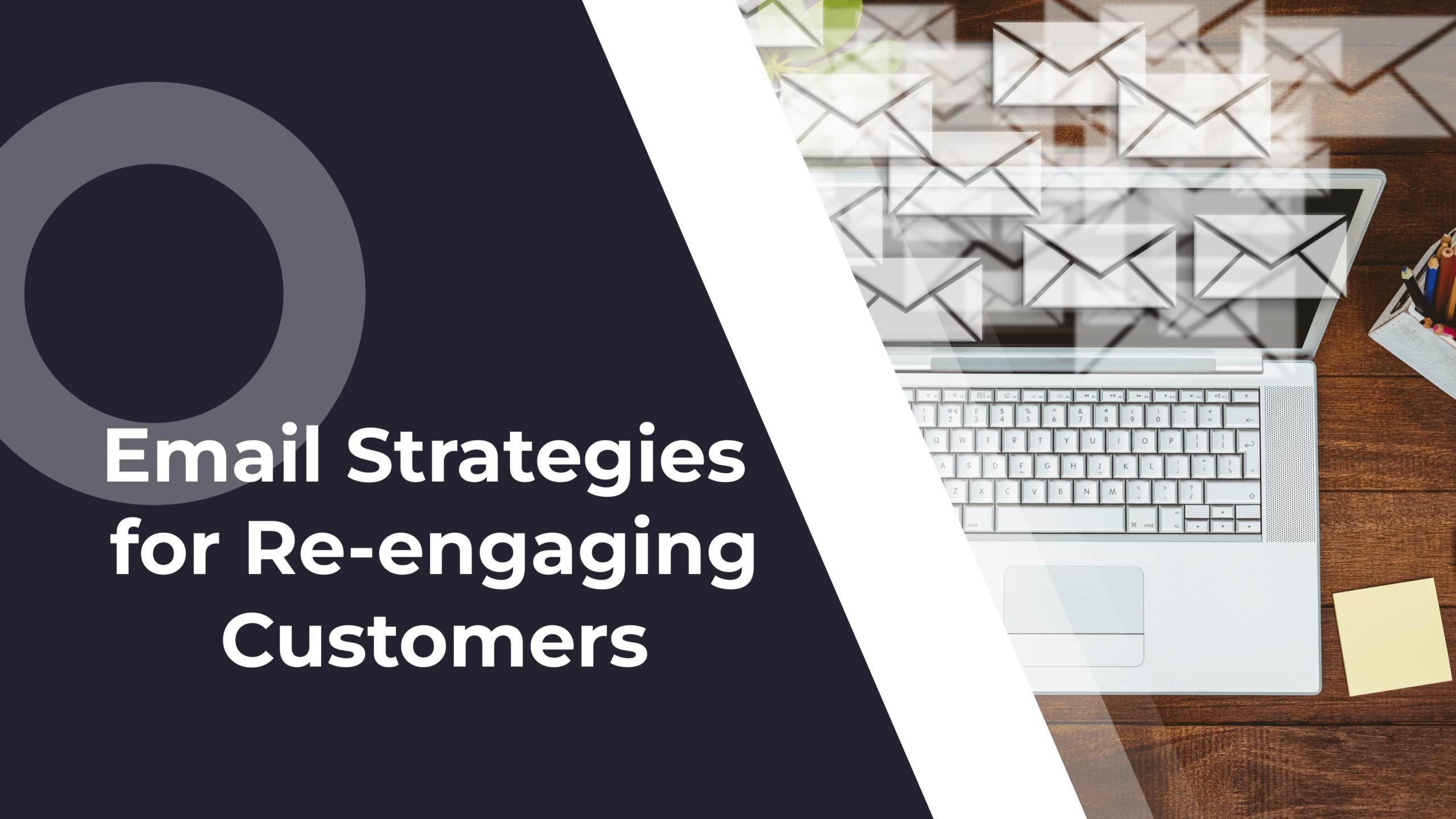In many SaaS businesses, customer success is treated as a post-sales activity to help ensure customer satisfaction and retention.
Meanwhile, the entire pre-sales and customer acquisition process seems to be completely delegated to the sales teams. Or, at least, that was the standard for a long time — but not any longer.
To get an idea of the role that customer success should play during customer acquisition, we reached out to some of the brightest minds in the industry. Here’s what they had to share!
1. “Customers are looking for experts to talk to, this is a great way to set up the CSM as the expert on hand” — Peter Sterkenburg
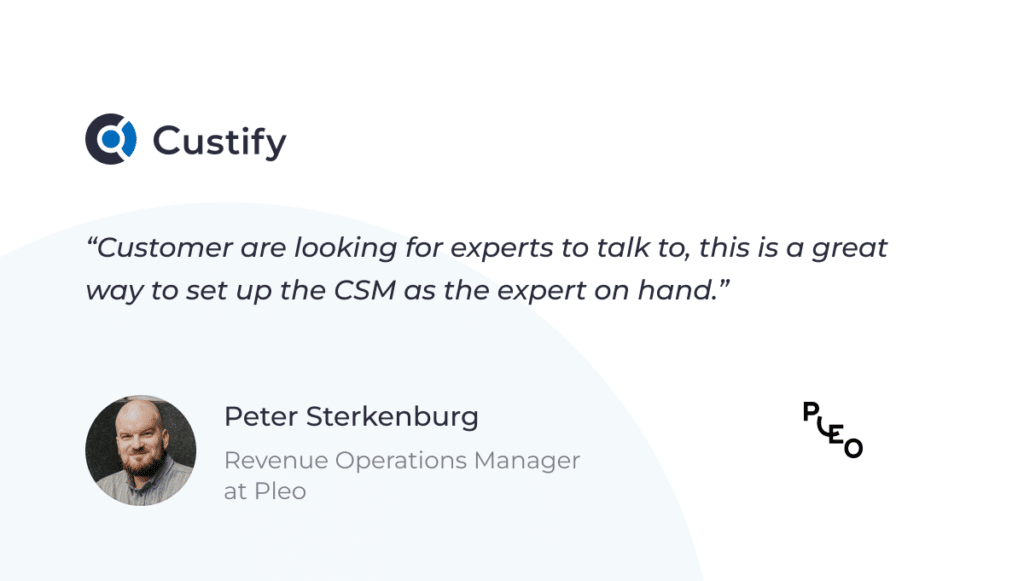
“From a relationship perspective, it breeds trust for the prospective customer, to know who and what’s next in the process. Especially when it’s a potentially larger implementation/onboarding project you are looking at.
The building of trust is crucial to help deliver and also to build the network of key contacts with the customer.
From a knowledge perspective, especially when the teams are organized by, for example, industry, it’s good to have an industry expert + a tool expert on hand to help provide additional context on a prospect call. Customers are looking for experts to talk to, this is a great way to set up the CSM as the expert on hand
From an internal perspective: it helps create trust between the Sales and the CS teams, and consequently, Sales/CS handovers will become better too.”
Peter Sterkenburg, Revenue Operations Manager at Pleo
Just like Peter said, trust is key to a successful relationship with a customer — and there is hardly a better gateway to trust than expertise. CSMs can establish that expertise and, as a result, trust by engaging with customers during the acquisition phase.
2. “Value is the characteristic that links the Sales teams and the Customer Success teams together” — Claudiu Murariu
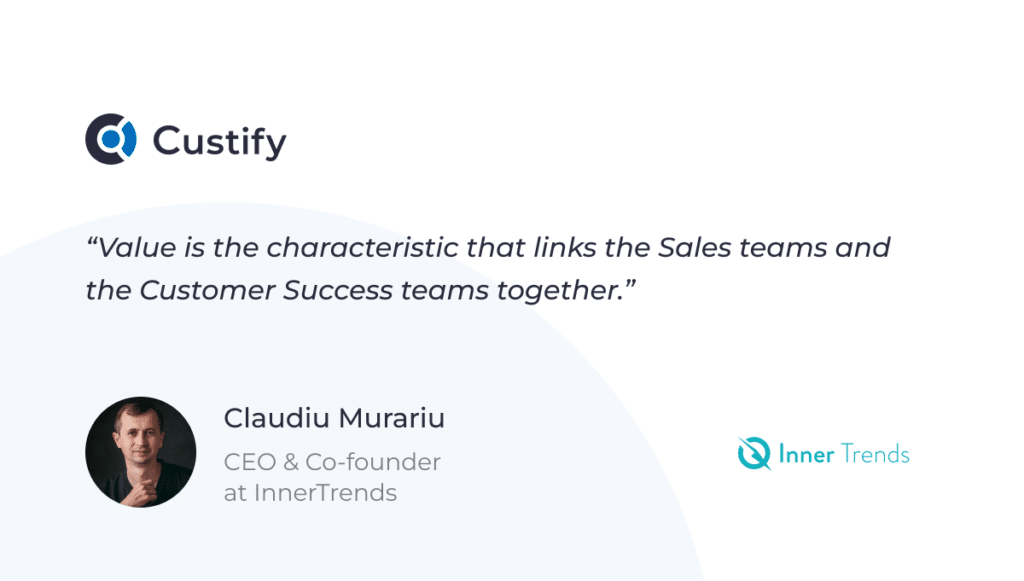
“To ensure that the customer is receiving increased value is, in my opinion, the primary responsibility of a customer success rep. Because they are getting more value out of the product, customers are more likely to pay a higher price for it or upgrade to a higher tier of service.
It is the responsibility of the salespeople to ensure that they discover opportunities in the data of the potential customers that they can close more quickly and effectively. They accomplish this by demonstrating the value that the product is capable of delivering to the customer.
Therefore, value is the characteristic that links the Sales teams and the Customer Success teams together.
It should come as no surprise, then, that the best results are achieved when the customer success team, the sales team, and the product team all collaborate on determining what the definition of value is and how to bring more people to that definition more quickly.
Customer Success has a great deal of experience in a variety of situations in which customers obtain value, whereas Sales has a great deal of experience in the emotional aspect of how to drive people to pay once they have obtained value. By cooperating, they will be able to increase the number of people who benefit from their efforts and the number of people who are willing to pay for those benefits.”
Claudiu Murariu, CEO & Co-founder at InnerTrends
Claudiu makes an often-overlooked point — despite the differences in their purpose, one thing that Sales and Customer Success have in common is driving value for customers.
Moreover, each has its own unique approach to showcasing value. So, by integrating each approach into the customer acquisition process, Sales and CS teams can work together to identify upsell opportunities and push the prospects to convert more quickly and easily.
3. “An open communication loop between Sales / Sales Engineers and post-sales is really important” — Brittany Yandura

“I think an open communication loop between Sales / Sales Engineers and post-sales is really important.
Any learnings we gain from CS we share back with sales to make our demos and acquisition process stronger and more accurate. Sometimes, we also have post-sales folks join customer acquisition calls for more nuanced questions or to sell the post-sales experience.
CS also can share ideas for prospecting email content based on what they are hearing from current customers about trends and pain we can solve for.”
Brittany Yandura, Customer Success Manager at Fieldguide
According to Brittany, whenever CS teams join the acquisition process, the benefits come on two fronts. On the one hand, directly engaging with a prospect during acquisition can give them the opportunity to successfully sell the CS experience that the customer will get in the post-sales.
On the other hand, they can also share their past post-sales experiences with Sales to improve the future pre-sale experiences for the prospective customers. This goes to show that the dynamic between pre-sales and post-sales is not a one-way street —there are always opportunities to improve and perfect the practices of both.
4. “CS can be a differentiator in the sales process” — Jeri Borland
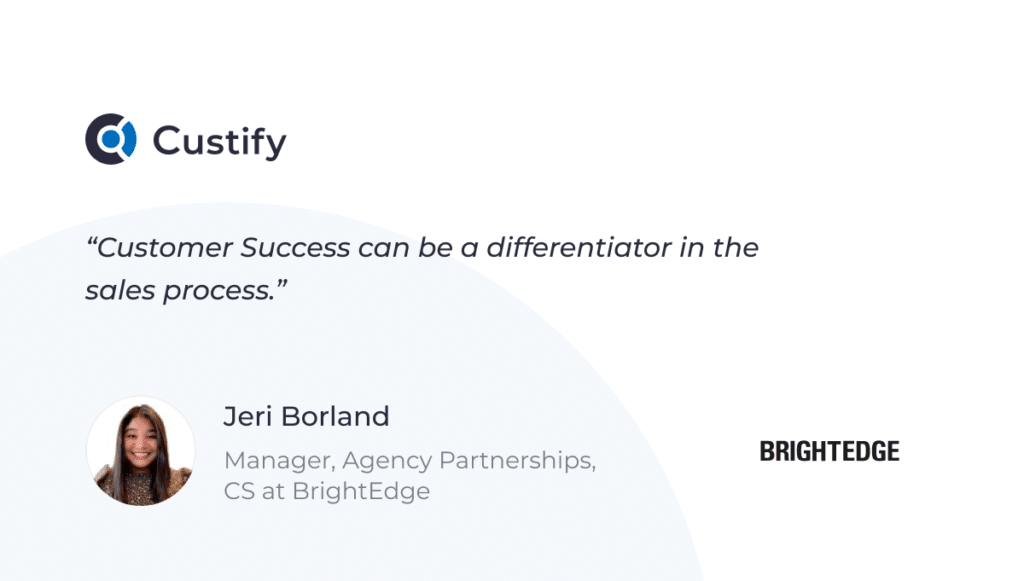
“Another way to partner is to involve CS in the sales process, whether it’s directly by joining a call to demonstrate what a customer success manager would provide them (in SaaS it could be reviewing insights and data together).
If the sales motion is not currently under revenue held by a CSM, usually CS leadership can partner here — or there could be anonymized client material from the CS team that the sales team can use for similar examples.
In many cases, CS can be a differentiator in the sales process, so showcasing the post sales support, I think, is important.”
Jeri Borland, Manager, Agency Partnerships, Customer Success at BrightEdge
The point that Jeri touches upon here may be counterintuitive, but that doesn’t make it less true — the pre-sales experience often depends on the post-sales experience to be successful, the two don’t exist in their respective vacuums.
That’s why involving a CSM in the acquisition process can strengthen the sales experience, as the post-sales support that they will showcase effectively becomes an upsell of its own.
5. “Nothing attracts customers more than the idea of realizing a rapid return of investment” — Delia Visan
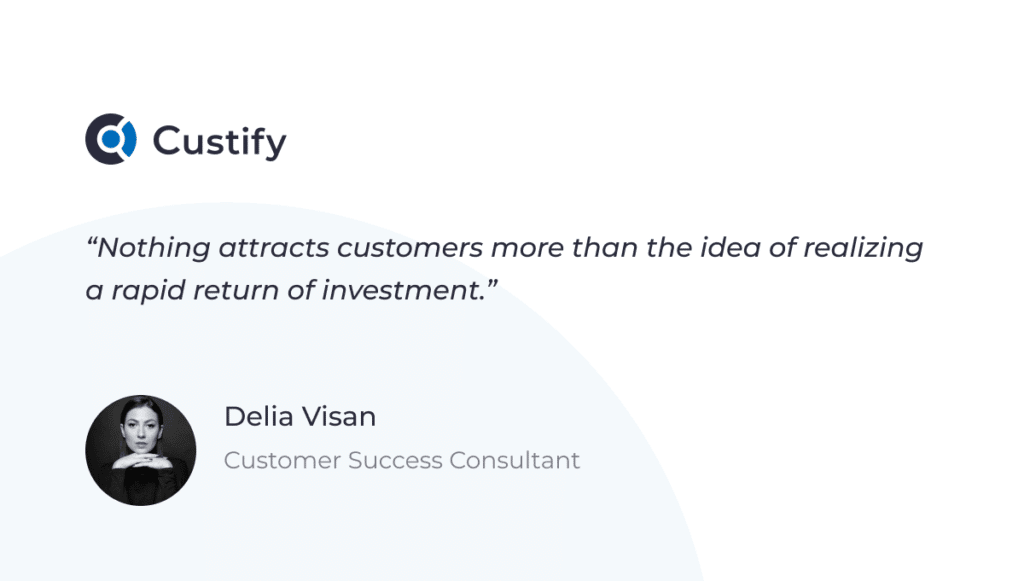
“Customer Success teams can influence the Customer acquisition process in several ways, two of which I consider the most important.
First, Customer Success teams maintain relationships with the current customers, which means they know better than anyone the existing types of customers from the company’s portfolio. So, by analyzing the customer profiles in their portfolios, CS teams can make recommendations on the Ideal Customer Profile (ICP) so that the focus can be placed in the right direction, and the Marketing team can spend the Customer Acquisition budget accordingly.
Secondly, nothing attracts customers more than the idea of realizing a rapid return of investment. Any success story that the CS teams can highlight and share with the Marketing team and then with the public can contribute to a successful Customer Acquisition process.
As for tips and tricks on the matter, the best way for the public to remember a success story is for it to be told loud and clear. Storytelling has its own way of working its magic.”
Delia Visan, Customer Success Consultant
Delia is right — few people in an organization have more insight into the company’s ICP than the CS team. As such, the CS team’s involvement in the acquisition process can save the sales team time and effort by identifying the prospects that fit the company’s ICP the most. By integrating a well-defined customer acquisition model, businesses can further enhance the efficiency of their acquisition strategies, ensuring they attract customers who align perfectly with their value proposition.
6. “You get valuable success stories that you can leverage to drive acquisition” — Mustafa Yilmaz

“There are many evident ways CS teams can help with acquisition efforts. By assisting clients to be successful with the product, you not only improve retention, but you get valuable success stories that you can leverage to drive acquisition: case studies, positive reviews, and referrals.
Product documentation is an additional and maybe not-so-obvious asset that customer success (and customer support) teams can leverage to improve product adoption, usage, and satisfaction. 24/7, in-context, and seamless access to product documentation can go a long way in answering questions users or their technical teams have BEFORE and after purchase.”
Mustafa Yilmaz, Senior Customer Success Manager at Archbee
As Mustafa suggests, your clients can be an invaluable source of stories and insights that can help you strengthen your acquisition process — especially your happiest clients. Information in general, including product documentation and knowledge bases, is what can often define your customers’ experience with your product.
7. “The most important aspect of a great team is communication at all stages of the customer experience” — Peter Ord
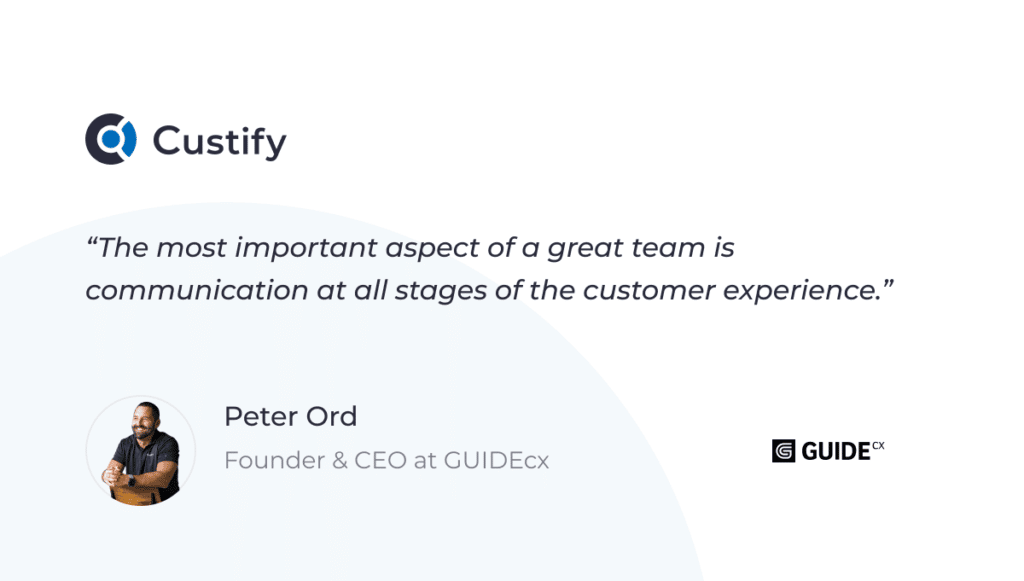
“Increasing the confidence a customer has in your company should be the main goal in every interaction you have.
Following this principle, an example might be to clearly outline the roles, responsibilities, and deliverables required by all teams in order to ensure a win/win. Help them know that you have a proven playbook for success. I believe the most important aspect of a great team is communication at all stages of the customer experience.
If a customer churns because they weren’t an “Ideal Customer,” make sure there is an open line of communication to your sales and marketing leaders so that this type of customer isn’t pushed across the 1-yard line.
If a prospect is in the final stage of the sales journey, and your team is just “waiting for signature,” be proactive and schedule an “Air Traffic Controller” call to help the prospect know what will happen when the contract is signed. This will help ensure a smooth landing.”
Communication is really key to a productive dynamic between the different teams at all stages of the customer journey, just like Peter said. Naturally, that also includes the acquisition phase, during which CSMs could and should share their insights into the ICP with Sales and Marketing.
8. “Marketing, sales, and product strategies directly impact the work of Customer Success teams” — Irina Vatafu
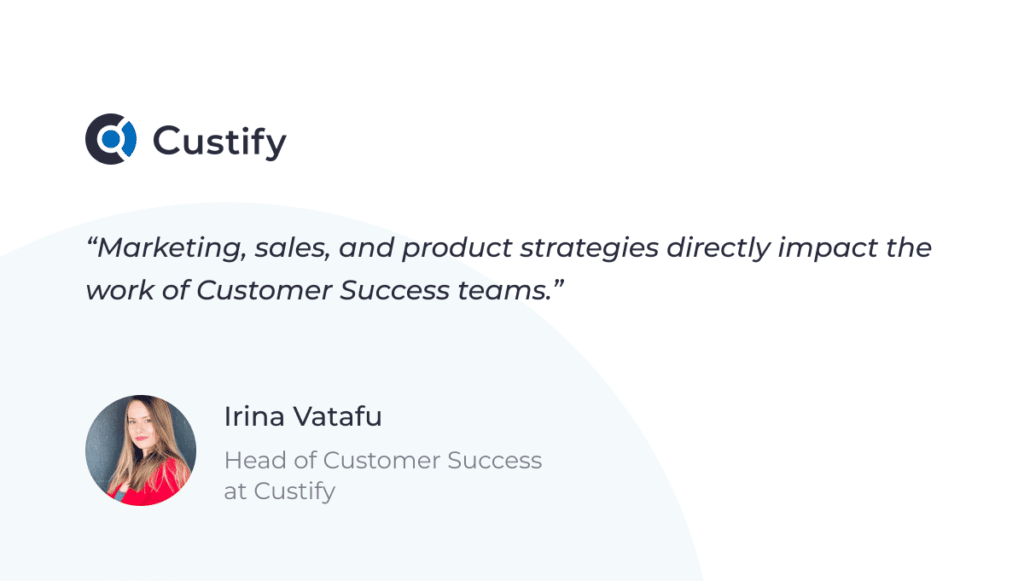
Customer Success Teams need to be aware of how important their role is in the pipeline.
Marketing, sales, and product strategies directly impact the work of Customer Success teams. However, the Customer Success team members are the customers’ advocates. Therefore, collaboration between departments needs to be very close, and CS teams need to constantly share customer complaints, feedback requests and the different patterns they observe.
This way, everyone will be pulling in the same direction and working towards the same goal – and that goal can be winning ICP customers for whom time to acquire, but also time to value is short.
Selling to the right customers at the right time can lead to a smoother acquisition process, better customer retention, less churn and more upselling opportunities.
Irina Vatafu, Head of Customer Success at Custify
At the end of the day, the main goal of a successful acquisition strategy is not only to sign a new customer, but also unlock insights into how the acquisition process can be improved for future customers, as well as how to improve customer retention and reduce churn.
As Irina puts it, CSMs are the customer advocates — which means that they possess all the insights into the customers to make that happen
Conclusions
As the experts featured in this article confirm, customer success more than belongs to the acquisition phase.
From providing unique insights into the Ideal Customer Profile to streamlining communication and collaboration between all the teams involved in acquisition, CSMs can help improve your acquisition strategy with their direct involvement in the process.
